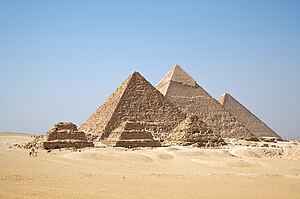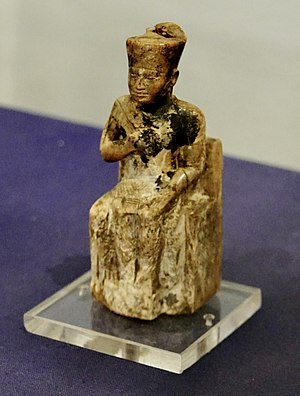26th century BC Chr.
Portal history | Portal Biographies | Current events | Annual calendar
◄ |
4th mill. Chr. |
3rd millennium BC Chr. | 2nd mill. Chr. ►
◄ |
28th century BC Chr. |
27th century BC Chr. |
26th century BC Chr. |
25th century BC Chr. |
24th century BC Chr. |
►
The 26th century BC Chr. Began v on January 1, 2600. And ended on December 31, 2501 BC. This corresponds to the period 4550 to 4451 before today or the interval 4069 to 3977 radiocarbon years .

The pyramids of Giza , on the left Mykerinos, in the middle Chephren and on the right that of Cheops ("Great Pyramid")
Age / Epoch
- Subboreal (3710-450 BC).
- Nordic Middle Neolithic in Northern Europe (3300 to 2350 BC).
- End Neolithic (2800 to 2200 BC) in Central Europe .
Events / developments

Collars and reconstructed Puabi headdress , British Museum
- around 2600 BC Chr .:
- Beginning of the 1st Dynasty (Dynasty of Awan) of the Elam Empire .
- Trade relations of the Sumerians with the Dilmun culture , Magan and Meluḫḫa .
- High time of the pyramids construction with the erection of the pyramids of Giza
- In the Indus culture , the small villages are transformed into uniformly constructed cities with several thousand inhabitants who were no longer primarily active in agriculture. The heyday of Harappa began , a historic city on the upper reaches of the Indus in today's Pakistan . It was from 2600 BC. Until 1800 BC Chr. , A center of the Indus Valley Civilization.
- Tall Leilan in Syria is developing into a big city.
- Establishment of the Chalcolithic settlements of Los Millares and Zambujal in Iberia .
- The Maya language emerges in the Sierra de los Cuchumatanes in Guatemala .
- With around 1000 inhabitants, Caral becomes the oldest city in the New World.
- Around 2580 BC Chr .:
- The Cyclades are heavily influenced by the Minoan culture of Crete . The mother goddess , worshiped in Delos , rises to become a supra-regional deity.
- Around 2550/2500 BC Chr .:
- Meskalamdug establishes the 1st Dynasty of Ur (in the short chronology 2436 BC).
- Royal Tombs of Ur , an early dynastic burial ground of the 1st Dynasty of Ur. In addition to Meskalamdug and Puabi, a large number of entourage were buried.
- Around 2550 BC Chr .:
- Pharaohs of the 4th dynasty send expeditions to the western desert oases such as B. Dachla , especially for the production of color pigments .
- Under Ur-Pabilsag comes the standard of Ur .
- Around 2530/2500 BC Chr .:
- Mesilim von Kiš, as an arbitrator in the Lagaš-Umma War, set up a border stele to pacify, but this was not respected in the further course.
Inventions and discoveries
Buildings
- Perhaps in the 26th century BC The Great Sphinx of Giza was built. Whether the Egyptian pharaoh Cheops or Chephren was the builder of the Sphinx is still a matter of dispute. In any case, the Sphinx cannot have been built before the Great Pyramid .
- From 2600 BC Chr .:
- The bluestones are set up in Stonehenge (phase 3 I) and then the sarsen stones (phase 3 II - 2600 to 2400 BC)
- Around 2600 to 2580 BC Chr .:
- Construction of the Great Pyramid in Giza .
- Around 2550 to 2530 BC Chr .:
- The Chephren pyramid in Giza is completed.
- 2548 BC Chr .:
- A boardwalk is being laid through the rain moor of Nieuw-Dordrecht in the Netherlands .
- 2540 to 2520 BC Chr .:
- Construction time of the Mykerinos pyramid in Giza.
Personalities
Note: The years of government cannot be precisely determined in this century. Therefore, these are approximate estimates.
Pharaohs of Egypt
4th dynasty:
- Cheops (2620-2580 BC)
- Radjedef (2580-2570 BC)
- Chephren (around 2572-2546 BC)
- Bicheris (around 2530 BC)
- Mykerinos (before 2539 – around 2511 BC)
- Shepseskaf (2510-2500 BC)
- Thamphthis (around 2500 BC)
Kings of Kiš
- Enmebaragesi (2615-2585 BC)
- Agga (2585-2550 BC)
King of Lagaš
- Enheĝal (around 2550 BC)
Emperor of China
Archaeological cultures
Cultures in North Africa
- The Tenerife (5200 to 2500 BC) in the Ténéré desert with the Gobero site is coming to an end
- In Nubia from 3200 BC An organized society, which, however, lasted until 2600 BC. Remains a vassal of Upper Egypt
-
Egypt :
-
Old Empire :
- 4th Dynasty (2670 to 2500 BC)
-
Old Empire :
Cultures in Mesopotamia and the Middle East
- Early Dynastic Period in Mesopotamia ( Sumer ):
-
Iran :
- Jiroft culture (4000 to 1000 BC)
- Schahr-e Suchte II (2800 to 2500 BC)
- Elam : Old Elamite Period (2700 to 1600 BC)
- Susa IVA (2600 to 2400 BC)
- Tepe Yahya IV B (3000 to 2500 BC), Proto-Elamite
-
Syria :
- Tell Brak (6000 to 1360 BC)
- Tall Leilan (5000 to 1726 BC) - Phase IIId and IIa
- Tell Chuera (5000 to 1200 BC)
- Tell Hamoukar (4500 to 2000 BC)
- First Kingdom in Ebla (phase Mardikh IIa - 3000 to 2400 BC)
-
Turkey :
-
Troy :
- Troy I (2950 to 2550 BC)
- Troy II (2550 to 2200 BC)
-
Troy :
-
Bahrain :
- Dilmun culture (3000 to 600 BC)
Cultures in East Asia
-
China :
- Yangshao culture (5000 to 2000 BC), central and northern China
- Yingpu culture (3500 to 2000 BC) in Taiwan
- Liangzhu culture (3400/3300 to 2200 BC) in southeast China
- Longshan culture (3200 to 1850 BC) on the middle and lower Yellow Rivers
- Karuo culture (3200 to 2000 BC) in China and Tibet
- The Shanbei culture (3050 to 2550 BC) in Jiangxi is coming to an end
- Majiayao culture (3000 to 2000 BC) on the upper Yellow River
- Xiaoheyan culture (3000 to 2000 BC) in Inner Mongolia
- Tanshishan culture (3000 to 2000 BC) in Fujian
- Shijiahe culture (2600 to 2000 BC) on the middle Yangtze
-
Korea :
- Middle Jeulmon Period (3500 to 2000 BC)
-
Japan :
- Middle Jōmon Period - Jōmon IV (3000 to 2000 BC)
-
Vietnam :
- Đa-Bút culture (4000 to 1700 BC)
- Hồng Bàng dynasty (2879 to 258 BC)
Cultures in South Asia
-
Indus Valley :
- Indus culture : Harappa phase, Harappa 3A (2600 to 2450 BC)
-
Balochistan :
- Mehrgarh : Period VII (from 2600 to 2200 BC), the city is largely abandoned
- Nal culture (3800 to 2200 BC)
Cultures in North Asia
- Disappearance of the Afanassjewo culture (3500 to 2500 BC) in southern Siberia ( Altai region)
- Glaskovo culture (3200 to 2400 BC) in Siberia , Mongolia and Southeast Russia
Cultures in Europe
- Northern Europe :
- Boat ax culture (4200 to 2000 BC) in Scandinavia and the Baltic States
-
Northeast Europe :
- Pit ceramic culture (4200 to 2000 BC - radiocarbon method : 5600 to 2300 BC) in Norway , Sweden , the Baltic States, Russia and Ukraine
- Rzucewo culture (5300 to 1750 BC) in the Baltic States and Poland
- Narva culture (5300 to 1750 BC) in Estonia , Latvia, and Lithuania
-
Eastern Europe :
- Yamnaya culture (3600 to 2300 BC) in Russia and Ukraine
- Fatyanovo culture (3200 to 2300 BC according to Anthony) in Russia
- Kura Araxes culture (3500/3000 to 2000/1900 BC) in the Caucasus
- The Esero culture (3300 to 2700/2500 BC) in the eastern Balkans is coming to an end

Coil-shaped pyxis from Chalandriani, Syros , FK II
-
Southeast Europe :
-
Greece :
- Mainland Greece, Early Helladic phase FH II (2700 to 2200 BC)
-
Cycladic culture (3200 to 1100 BC), early Cycladic phase FK II (2700 to 2200 BC) with
- Keros-Syros culture (2700 to 2300 BC)
- Crete - Early Minoan pre-palace period FM II (2700 to 2200 BC)
-
Greece :
-
Central Europe :
- Remedello culture (3400 to 2400 BC) in northern Italy
- Vlaardingen culture (3350 to 1950 BC) in the Netherlands
- Gaudo culture (3150 to 2300 BC) in southern Italy
- Schönfeld culture (2900 to 2100 BC) in Germany and the Czech Republic
- Individual grave culture (2800 to 2300 BC) in northern Germany, Poland , the Baltic States and southern Scandinavia
- Corded ceramics (2800 to 2200 BC) in Central Europe, the Baltic States and Russia
-
Western Europe :
- Grooved Ware Culture in Great Britain and Ireland (3400 to 2000 BC)
- End of Skara Brae on the Orkney Islands (around 3180 BC to 2500 BC)
- Peterborough Ware expired (3400 to 2500 BC) in Great Britain
- Chassey-Lagozza-Cortaillod culture (4600 to 2400 BC) in France, Switzerland and Italy
- Seine-Oise-Marne culture (3100 to 2000 BC) in northern France and Belgium
- Peu-Richard culture (2850 to 2150 BC) in central western France - recent level Peu-Richard II
- Almeria culture (3250 to 2500 BC) in southeastern Spain - Almeria II
-
Megalithic cultures :
- France (4700 to 2000 BC)
-
Iberian Peninsula (4000 to 2000 BC): Spain and Portugal
- Los Millares (3200 to 1800 BC)
- Vila Nova de São Pedro (2700 to 1300 BC)
- Malta : Tarxien phase (3300/3000 to 2500 BC) - Temple of Tarxien , Ħaġar Qim
- Grooved Ware Culture in Great Britain and Ireland (3400 to 2000 BC)
Cultures in america
-
North and Central America :
- Archaic period . Establishment of mounds in the eastern forest areas from 4000 BC. Chr.
-
South America :
- Chinchorro culture (7020 to 1500 BC) in northern Chile and southern Peru
- Valdivia culture (3950 to 1750 BC) in Ecuador
-
Norte Chico culture (3500 to 1800 BC) in Peru with
- Caral (from 3000 BC), Pre-Ceramic IV - VI
- San Agustín culture (3300 BC to 1550 AD) in Colombia
Individual evidence
- ↑ Mahmoud Rashad: Iran: History, Culture and Traditions: Ancient Sites and Islamic Art in Persia. DuMont Reiseverlag, 1998, ISBN 3-7701-3385-4 , p. 40
- ↑ Brigitte Beier: New Chronicle of World History. Wissenmedia Verlag, 2007, ISBN 3-577-14639-7 , p. 152
- ↑ Michael Witzel : The old India. CH Beck, 2010, ISBN 3-406-59717-3 , p. 19
- ↑ Sphinx of Giza . In: Pyramidenbau.info . Retrieved February 24, 2012
- ^ David W. Anthony: The Horse, the Wheel, and Language: How Bronze-Age Riders from the Eurasian Steppes Shaped the Modern World . Princeton University Press, Princeton, NJ 2007, ISBN 978-0-691-05887-0 , pp. 308 .
Web links
Commons : 26th century BC Chr. - collection of pictures, videos and audio files



